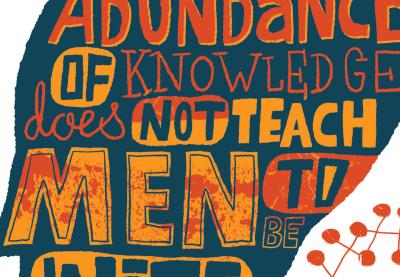This text is excerpted from The Social Neuroscience of Education, © 2013 by Louis Cozolino. Used with permission of the publisher, W. W. Norton & Company, Inc.
Is Science Relevant to Education?
Horace Mann, the founder of American public education, believed that pedagogy should be based on sound scientific principles. His science of choice was phrenology, which is the study of intelligence and personality based on the arrangement of the bumps on our heads. Thus began a long history of “science-based” (or, more accurately, pseudo-science-based) teaching.
The most recent trend of “brain-based learning” applies findings from cognitive neuroscience to the classroom. Many steps ahead of Mann’s phrenology, it attempts to apply what laboratory scientists have discovered about learning and memory to classroom education. The problem is that science is complex, challenging to learn, and difficult to apply. The result is that a few principles are taken out of context, turned into a sound bite or a list of “Ten Important Scientific Facts,” and come to nothing but a new set of clichés.
Most teachers are understandably skeptical and rightfully question the value of brain-based consultants who pepper standard educational dogma with words like neuron, cortex, and synapse. The fact is, there is no substitute for the instincts of a bright, dedicated, and caring teacher. On the other hand, a thorough knowledge of the nature, limits, and possibilities of students’ brains couldn’t hurt. While we are just at the beginning of attempting to apply neuroscience to education, it is hard to deny that the evolution and development of the brain is a potential treasure trove of information about where we have come from, what we are capable of, and how we learn. However, this knowledge must be well understood, integrated with what we know about social and emotional development, and made culturally relevant.
If you've ever wondered why social-emotional learning is important, wonder no more. Louis Cozolino lays out the scientific foundation for teaching kids "from the heart."
The Child's Brain in the Classroom
The brain has been shaped by evolution to adapt and re-adapt to an ever-changing world. In other words, the brain exists to learn, remember, and apply what has been learned. Learning and memory are dependent upon modifications of the brain’s chemistry and architecture in a process called “neural plasticity.” Neural plasticity reflects the ability of neurons to change both their structure and relationships to one another in reaction to experience (Buonomano & Merzenich, 1998; Trojan & Pokorny, 1999). We know that animals raised in enriched and more challenging environments have larger brains, longer neurons, and more synapses (Diamond et al., 1964; Guzowski et al., 2001; Ickes et al., 2000; Kempermann et al., 1998; Kolb & Whishaw, 1998). We also know that when adult humans engage in exploration, education, and challenging jobs, their brains become more complex, robust, and resistant to age-related diseases (Kessler et al., 2003; Scarmeas et al., 2004; Staff et al., 2004). Teachers use their personalities, interpersonal skills, and teaching methods to create enriched physical, conceptual, and social environments that stimulate neural plasticity, enhance brain development, and optimize learning.

The curriculum and social environment of a classroom have a synergistic impact on learning. Supportive, encouraging, and caring relationships stimulate students’ neural circuitry to learn, priming their brains for neuroplastic processes. Studies with birds have demonstrated that the ability to learn their “songs” can be enhanced when exposed to live singing birds versus tape recordings of the same songs (Baptista & Petrinovich, 1986). Some birds actually require social interactions to trigger brain plasticity (Eales, 1985). Studies of high-risk children and adolescents who show resilience in the face of trauma and stress often report one or two adults that took a special interest in them and became invested in their success. This underscores the fact that, like birds, humans engage more effectively in brain-altering learning when they are face-to-face, mind-to-mind, and heart-to-heart with caring others. This is how learning occurs in tribes and in tribal classrooms, where teachers and classmates are able to become family.
The Core Elements of Social-Emotional Learning
Brains grow best in the context of supportive relationships, low levels of stress, and through the creative use of stories. While teachers may focus on what they are teaching, evolutionary history and current neuroscience suggest that it is who they are and the emotional environment in the classroom they are able to create that are the fundamental regulators of neuroplasticity. Secure relationships not only trigger brain growth, but also serve emotional regulation that enhances learning. A low level of stress and arousal—where the learner is attentive and motivated to learn—maximizes the biochemical processes that drive neuroplasticity. The activation of both emotional and cognitive circuits allows executive brain systems to coordinate both right and left hemispheres in support of learning, affect regulation, and emotional intelligence. Let’s begin with a brief summary of each of the central elements of social-emotional learning. This is just a preview—we will return to these ideas throughout the coming chapters.

Safe and Trusting Relationships
It is becoming increasingly evident that facial expressions, physical contact, and eye gaze connect us in constant communication exchanges with those around us. It is within this interpersonal matrix that our brains are built, rebuilt, and regulated. A teacher’s supportive encouragement properly balanced with an appropriate level of challenge activates dopamine, serotonin, norepinephrine, and endorphin production at levels conducive to learning (Barad, 2000; Huang et al., 1999; Kang & Schuman, 1995; Kilgard & Merzenich, 1998; Kirkwood et al., 1999; Tang et al., 1999). Through these and other biochemical processes, teacher-student attunement creates states of mind and brain that make students better able to incorporate, recall, and use new information.
From a neurobiological perspective, the position of the teacher is very similar to that of the parent in building a child’s brain. Both can enhance a child’s emotional regulation by providing a safe haven that supports the learning process. This “holding environment” optimizes neuroplasticity, allowing for new learning (Kegan, 2000). Among the many possible implications of this finding for the classroom is the fact that teacher-student attunement isn’t a “nice addition” to the learning experience, but a core requirement. This is especially true in cases where children come to class with social, emotional, or intellectual challenges. The social brain takes into account both what we are learning and from whom we are learning it.

